A Story Three Decades in the Making
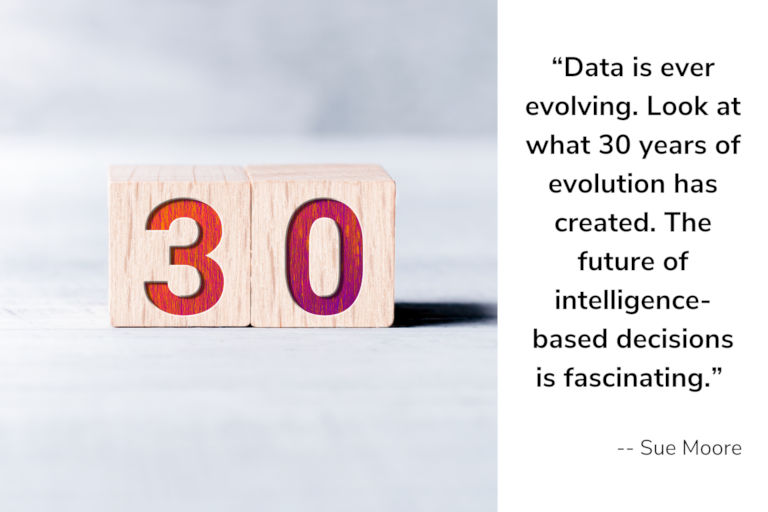
Milestone birthday alert. FreeWave turns 30 in 2023 and I’d like to take you on a journey of data over the last three decades – taking a look at where data has been and its sci-fi-like role in our future. Since FreeWave is all about transforming data into real knowledge for real people, I drew from a broader perspective about the bits and bytes of the data of life. The ideas here are inspired by FreeWave’s innovation team. From a serial inventor to our founder, each has shaped the field of technology in their own right. Sure, the first time someone uttered the words “big data” (October 1997, in case you’re curious) is interesting, but how has the term itself changed the way we live and work? As Steve Jobs said: “You can’t connect the dots looking forward; you can only connect them looking backwards.” Thus, this is more taking stock of data’s backstory over a cold IPA than a mundane timeline. Thirty candles on the cake commands a little self-reflection. The wild days of our youth are behind us. We’re all grown up now, and while data may be following its own trajectory, the parallels are pretty fascinating. I start where all great stories begin. My “why.” I grew up in the Midwest where a lot of the technology that we use today was born and innovation spans generations. I remember “playing office” with with my father’s paperwork at home (I guess remote offices were a thing, back in the day). He worked at Motorola (a company I would later join) for decades. He was a regional sales rep during the the early 80s when he was on special assignment, working on this thing called “cellular.” His company car’s trunk was filled with black boxes – and there was even a phone mounted in the center column between the front seats. It was cool to use. I thought I was cool for being able to use it. So, I was hooked, not only on technology, but the data seemingly flying there and there to make that all possible. From there, I guess I just followed in Dad’s footprints, although I chose a marketing path, and 40 some years later, here I am, still watching technology expand. Still fascinated by how those ones and zeroes are writing the world’s story. It’s 1993: Do You Know Where Your Floppy Disks Are? The year is 1993. Bill Clinton is president, Beanie Babies have hit the market, Intel has introduced the Pentium microprocessor, and 3½ inch floppy disks in bright colors are scattered across desks (unlike its austere sibling, the silver compact disk). In a small office somewhere in Boulder, Colorado, the FreeWave cofounders are meeting with a couple of ladies who make dreamcatchers. FreeWave was born among the likely stacks of floppies used to store code for FreeWave products to come. And, we can’t forget that the then new Colorado Rockies threw out its first pitch in the National League West (to date, we have never won our division – but, boy, we’ve got great mountain views!). “When we first started, wireless was used in many applications, but not to anywhere near the extent it is today. The early applications for our products were the precursor to IIoT (Industrial Internet of Things) and showed how important data was,” says Steve Wulchin, CEO and cofounder of FreeWave. After earning his MBA at the University of Texas, Steve was hired by Hewlett Packard. His first desktop computer at HP had a 5MB hard drive (yes, megabytes!). Cell phones and the internet didn’t exist, and Apple was a company that was pretty much left for dead by the rest of the tech world. That, he says, is the cool thing about technology. “Look at where we are now,” he says. “We may not have flying cars, but we do have a lot of unbelievable things that few could have imagined back then.” Like technology, life has its own twists and turns. “I never planned to move to Houston post-college, never planned to get an MBA, and absolutely never planned to start a company,” says Steve. Yet, he did. FreeWave has come a long way and is now innovating around end-to-end solutions so companies better understand operational, performance, and revenue opportunities through their data. Also from the 90s, computer scientist Michael Lesk writes: “There may be a few thousand petabytes of information all told.” (IDC predicts the global datasphere will reach 175 Zettabytes by 2025.) Using data as insight also saw the light of day. In 1993, digital mobile phones went from analog to digital, giving way to applications, data transfer, and mobile hotspots. In 1995, M2M began using cellular as a backhaul solution. And in 1999, SMS pricing and data plans fell to affordable rates. Things, the Rise of Data in the Aughts and the Value of Insight Once people realized Y2K (for zoomers, this was the potential crash of computers on December 31, 1999) was a non-issue, the world was off and running. We snapped photos with our phones, put our taxes on flash drives, carried a thousand songs in our pocket, and connected on Facebook. During the 2000s, “things” like washing machines were predicted to connect to the internet and order detergent. So far, most of us are still putting Tide on the grocery list. However, IoT has indeed given rise to a tsunami of data. According to the IoT Analytics “State of IoT—Spring 2023” report, the number of global IoT connections grew by 18% in 2022 to 14.3 billion active IoT endpoints. In 2023, the global number of connected IoT devices is predicted to grow another 16%, to 16.7 billion active endpoints. In the plainspoken world of marketing where I play, a “billion active endpoints” is a lot of data flowing through a lot of connected things. The term “big data” was first used at an IEEE conference on visualization in 1997. Michael Cox and David Ellsworth authored “Application-Controlled Demand Paging for Out-of-Core Visualization,” stating: “Visualization provides
The Whats and Hows of the Ultimate Dashboard for Industrial IoT
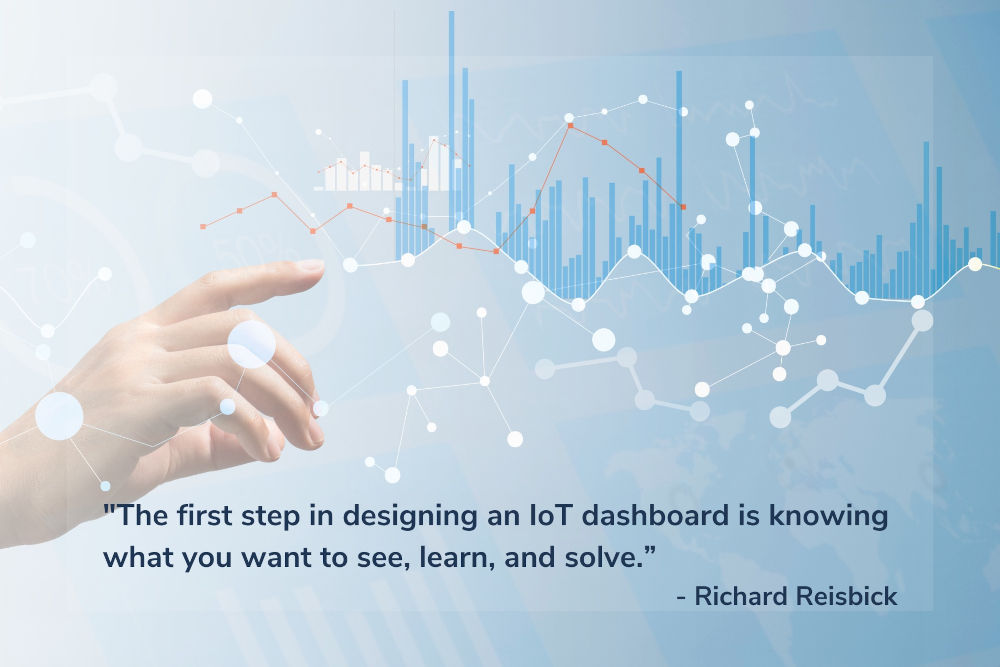
If you use the internet of things (IoT) devices to monitor or automate certain business operations, you may be wondering what to make of all the data those devices generate. Collectively, IoT devices across the globe will generate almost 80 zettabytes of data by 2025, according to International Data Corporation (IDC) projections. A zettabyte equals a trillion gigabytes. In layman’s terms, we’re talking about oodles and scads and gobs of data. At the business level, data collected from IoT-enabled devices could conceivably be entered into a spreadsheet, but data presented in this manner becomes overwhelming and even incomprehensible. A much better way to store and make sense of your data comes in the form of an IoT dashboard, which visually represents relevant data in such a way that you gain at-a-glance, actionable insights regarding your operations. An effective IoT dashboard allows you to make data-driven decisions to optimize efficiencies, troubleshoot problems, and make other adjustments and improvements that could potentially impact profit margins. Dashboard Design and the KISS Principle — Keep it Simple, Stupid Think about the dashboard display in your car. It doesn’t show you everything there is to know about the vehicle. Imagine how overwhelmed and distracted you would feel if it presented you with minutiae such as the condition of your tire tread, how many cubic inches of trunk space you’re using, the precise amount of antifreeze you have, the decibel level you top out at when singing along with the radio, and so on, ad nauseam. All this information crammed onto your dashboard would make it difficult for you to drive and make important, time-sensitive decisions, like when to stop for gas. That’s why the dashboard display is limited to what you need to know to drive safely and efficiently: How much fuel do you have? How fast are you going? How many miles per gallon are you getting? A well-designed IoT dashboard also only shows you data that you’ve prioritized in accordance with your business objectives, with the ability to pull up additional data points as desired. A well-designed dashboard prompts you to a view of data sets that you can select, creating an unfussy, easy to understand, and up-to-the-minute snapshot of in-field device and system-level performance. Effective Dashboard Design — It All Starts with You When it comes to selecting the best IoT dashboard for your organization, the first step is to define your business goals. Before requesting demos or engaging an IoT dashboard vendor, identify what you want to learn and achieve with the data you collect. Your business goals will determine the dashboard design you choose, as well as the type of data and performance indicators you need to track to meet your goals. For example, if your business goal is to improve the efficiency of your manufacturing process, you might want to track equipment downtime, production output, and raw material usage. Another scenario might be an oil and gas company wanting to track performance by optimizing existing wells, improving oil recovery, and minimizing its carbon footprint or emissions. Having defined your business goals, you can then determine which metrics matter most and how best to display them to facilitate decision making. Then, you can look for a dashboard that has the necessary features and functionalities to help you meet your business objectives. Dashboard Deliverables — What You Should Look for When Evaluating Your Options IDC estimates there will be 55.7 billion connected IoT devices by 2025. The IoT dashboard and platform market, though still quite young, is growing exponentially. With an ever-increasing number of options, choosing which vendor and product will best support your business goals can be as easy as working with a leading IoT network provider. We will discuss what to look for when considering your options, after a brief clarification of terms. You may hear the words dashboard and platform used interchangeably, so think of the dashboard as the user interface within an IoT platform that allows you to interact with your connected devices. The dashboard is both a control panel and a visual representation of key data your IoT devices collect. The platform is the dashboard’s pre-built foundation. Platform-based dashboards are typically more practical than out-of-the-box dashboard solutions, provided the platform is well-engineered. And a well-built platform is, first and foremost, generic. A Solid Generic Framework with Customizable Features and Functionalities In the case of information technology platforms, “generic,” ironically, is a positive descriptor, synonymous with user-friendliness and adaptability. Generic IoT platforms allow for customization, and FreeWave’s data platform comes with an array of templates and widgets that allow you to create a custom dashboard almost as easily as snapping together those beloved Lego® building blocks from your youth. The lesson here is the less “generic” the platform, the greater the likelihood you’ll need to hire someone to configure your initial dashboard and reconfigure it time and again as your business strategy evolves. Effective dashboards are intuitive and interactive. They are not a data dump, but rather convey information hierarchically through charts and other data visualizations, enabling you to extract actionable insights, receive alerts, identify patterns and trends, make projections, and run various scenarios with the aid of built-in analytics and machine learning. If you want to dive deeper into your data, interactive drill-down and click-to-filter features guide you through multilayer displays. You by no means have to be a programmer to design an effective IoT dashboard, but if you need a little extra assistance, look to an IoT platform provider for help. As a convenience to customers, FreeWave is enhancing its distribution network with specialists trained to assist in defining your user interface, in accordance with your business goals. Decision-making Support Through Data Storytelling Designing an industrial IoT dashboard begins by defining what data you want to see and why. It’s an involved process, but the end result should be a simple data story, with key takeaways highlighted. Once you’ve created your ultimate IoT dashboard, you’ll gain a competitive edge for your organization as the intelligence embedded
IoT and the Carbon Market: How Data Can Help Drive Decarbonization
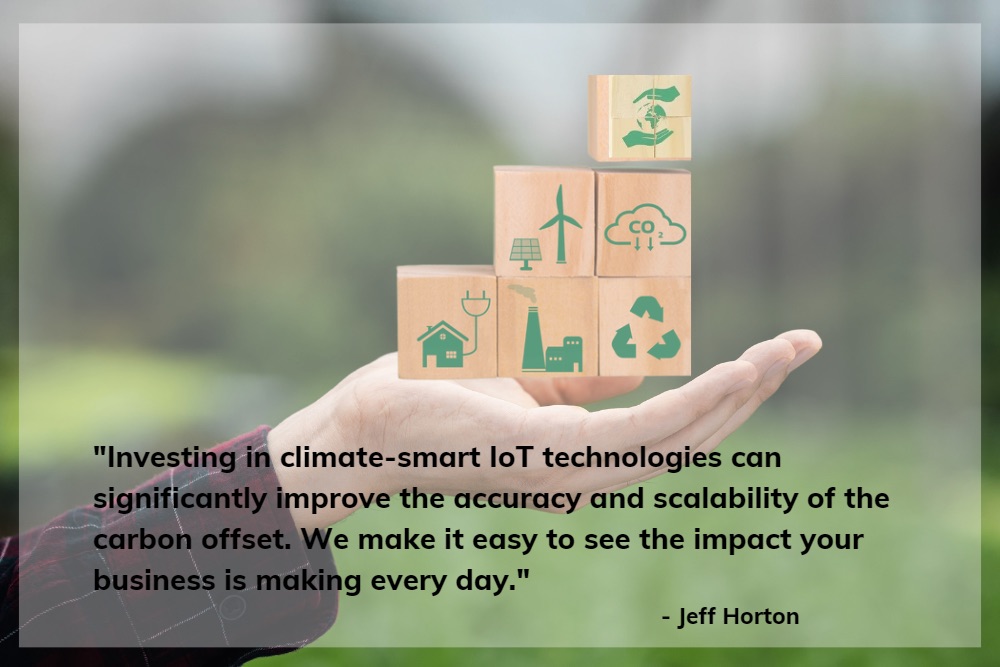
Let’s set the stage for what greenhouse gasses are by using a familiar scenario. You’re walking in a greenhouse. That warm, damp air that you feel on your skin and the additional sunlight that warms the space likens it to a 24/7 hot yoga session for plants. That, in a simple example, is the greenhouse gas effect. Now, take that greenhouse and expand it to the size of the planet. Imagine the world as one large terrarium with man-made greenhouse gasses (GHGs) trapping heat in the atmosphere. The impact, according to the United Nations Environment Programme (UNEP) Emissions Gap Report, is measurable and critically damaging to life on planet earth. Global temperatures are expected to rise at least 2.7C this century. The report goes on to say that GHGs need to be halved by 2030 to avoid a climate catastrophe. According to the Environmental Protection Agency (EPA), one of the leading GHGs is carbon dioxide (CO2), which accounts for 79% of all GHGs from human activities. Reducing CO2 (or decarbonization) is critical. The EPA points out that carbon emissions alter climate patterns and that “human health, agriculture, water resources, forests, wildlife, and coastal areas are all vulnerable to climate change.” Fortunately, data available from Internet of Things (IoT) technology can help accelerate decarbonization efforts as explained, in part, below. The Intersection of IoT and Carbon Markets As the world faces the challenge of reducing GHG emissions, industries are turning to regulated carbon credit markets and voluntary carbon offset markets to help them shrink their carbon footprints. Carbon markets — where carbon credits and offsets are sold and bought, similar to commodity futures like grain — provide a way for industries to compensate for unavoidable emissions by investing in certified projects that reduce or remove carbon dioxide from the atmosphere. These projects mitigate the environmental impacts of industrial operations while helping organizations work toward net-zero commitments and environmental, social, and governance (ESG) reporting goals. Carbon credit markets create accountability. Along with international pacts to drastically lower GHG emissions, consumer demand to reduce environmental harm is spurring carbon market growth. This demand is driven by deep-seated concerns that are literally keeping Americans up at night. A new survey from the American Academy of Sleep Medicine (AASM) reveals that one-third of adults (32%) “always or often” lose sleep due to worries about environmental issues. Investing in carbon offset projects shows that an organization’s commitment to combat climate change goes beyond lip service. A worldwide awareness of climate change could be one reason companies are taking note. The voluntary carbon market recently exceeded $1 billion in global value and could surpass $30 billion in annual value by the end of the decade, according to a Bain & Company report. While investments are clearly on the rise, “the carbon market has reached a crossroads,” the report states. That’s because carbon markets today are built largely on trust — and as it turns out, that trust is tenuous. Enter the critical role of data. Verification methods for carbon offsetting lack uniformity, which raises uncertainties about the fair market value of credits as well as doubts about the efficacy of the projects they fund. As a result, many organizations that need carbon offsets to meet their net-zero commitments have nevertheless chosen not to buy them. For carbon markets to achieve their potential, reliable emissions measurements and data are needed for valuation and verification. “Zero Trust” Begets Absolute Trust Leveraging IoT technology consisting of sensors, network configurations, and cloud-based analytics can significantly improve the accuracy, reliability, and scalability of the carbon offset verification process. That’s where FreeWave comes in and its partnership with Inmarsat to provide global coverage, collecting IoT sensor data from anywhere and transporting it to the cloud for analysis and action. The FreeWave platform has reputable third-party auditors who analyze data to confirm the efficacy of certified carbon offsetting projects. For example, in a reforestation project, auditors can accurately measure and convey to offset buyers how much carbon is being sequestered, and it won’t be long before buyers, through a dashboard, can track these measurements themselves and compare them against a projected scenario of how many tons of carbon emissions would have occurred were it not for the project. Using incontrovertible metrics to assess project performance increases investor confidence, while sellers can ensure that their credits are backed by measurable emissions reductions. This could ultimately help move the voluntary carbon market toward a more transparent, zero-trust model. When there’s absolute trust in carbon market performance, the value of carbon offsets will increase. That’s good news for industries like smart agriculture that can potentially capture more carbon than they produce, enabling them to sell offsets as an additional revenue stream. Beyond Carbon Markets — Sustainability Best Practices Carbon offsetting is part of a holistic sustainability plan that starts with reducing the use of fossil fuels and pollutants, taking carbon reduction efforts as far as possible before offsetting any remaining emissions. Here, too, IoT and FreeWave come into play, deploying technologies that improve operational efficiency while protecting and conserving natural resources. Growers, for example, can use sensor data to optimize efficiency for irrigation and fertilization programs. IoT data allows agriculture and other industries to monitor and manage their environmental impact. It also gives them data-based ESG impact reports that they can use to their competitive advantage — and to discredit accusations of greenwashing (exaggerated claims of environmental practices). Most business leaders (76 percent) in major industries doubt their peers’ ESG reporting, according to recent research by satellite solutions provider Inmarsat. Beyond the environmental and humanitarian imperatives, investing in climate-smart IoT technologies can be part of a long-term revenue enhancement strategy. We at FreeWave believe that products that are verifiably carbon-neutral will warrant premium pricing in the eyes of environmentally conscious consumers, just as produce grown organically commands a higher price. The Journey to Net-Zero Most business leaders believe that data collected via IoT solutions is critical to building trust (81 percent) and improving ESG outcomes overall
Satellite Connectivity Becomes Next-Generation Tech for Remote Operations
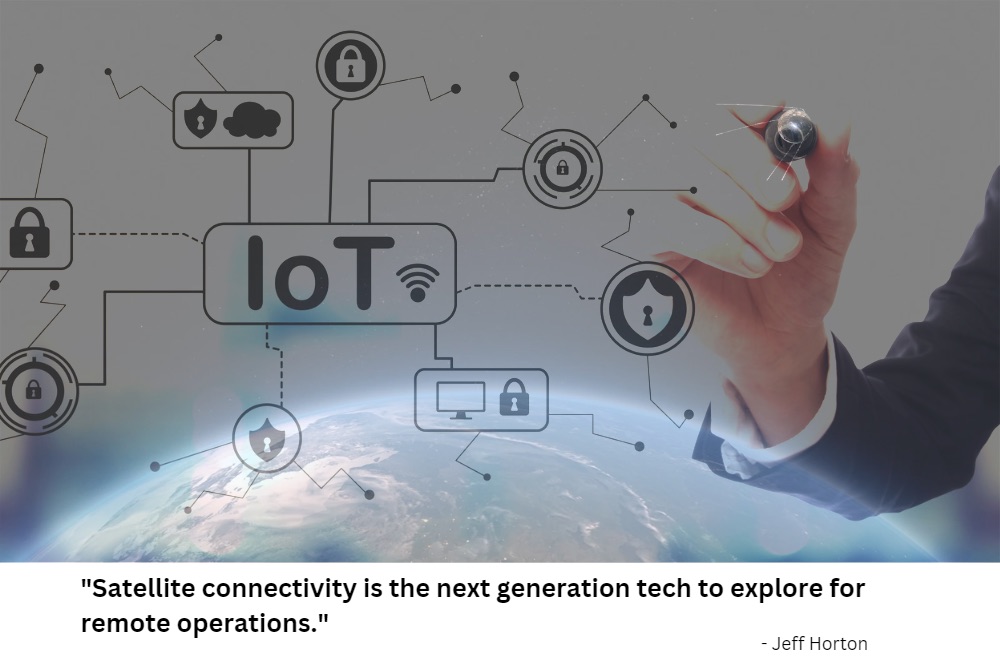
The future of IIoT connectivity is up in the air — literally. Space is the new frontier for IIoT connectivity, as satellite connectivity is fast becoming the networking solution of choice for many industrial use cases. IIoT, or the industrial internet of things, refers to an ever-expanding ecosystem of sensors, networking equipment, and analytics, which work together to collect, transmit, and analyze data from “things” used in industrial operations. Data transmissions from industrial assets help guide business decisions or automatically trigger actions. For example, in agriculture, IIoT-enabled irrigation systems monitor soil moisture levels, weather forecasts, and other data points to help growers determine the best time to water, or the IIoT solution can automatically activate sprinklers without human intervention if programmed to do so. When talking about satellite, this two-way communication reveals the next-generation tech for remote operations. First, though, let’s take a quick glance back. What Satellite Connectivity Means for People in Remote Areas FreeWave started by helping customers transmit mission-critical data using radio technology in 1993. We’ve seen the evolution of communications since then, with not only our rugged wireless radios continuing to serve the future of the oil and gas industry, but also the advancement of satellite for people leading remote operations. Traditionally, IIoT has mostly relied on cellular connectivity and other terrestrial solutions for data transmission, but as IIoT continues its push into underserved locations — from remote grazing pastures in Colorado to offshore oil platforms in the Pacific Ocean — cellular solutions pose some serious limitations. Connecting people, not things, is the foundational purpose of cellular infrastructure development, so in sparsely populated or remote areas, cellular service may be limited or even surprisingly unavailable. While other non-cellular connectivity solutions exist, for certain circumstances, satellite is becoming a more viable solution, offering distinct advantages. Competition is driving rapid innovation in the IIoT satellite space even as it drives down costs. As a result, companies that previously encountered lack-of-coverage or cost barriers with the various terrestrial networking options now have an affordable IIoT connectivity solution in the form of satellite — with cost savings between four and 20 times what they once might have paid. Satellite connections are, by definition, wireless and don’t require remote operators to install fixed lines — DSL lines or coaxial cable — for data transmission. This added flexibility gives companies the freedom to scale their IIoT applications quickly and easily as their needs and business goals evolve. For example, a major agriculture company with an expanding customer base in remote parts of Brazil, Argentina, and Chile announced it will use satellite connectivity to operate autonomously driven tractors in those countries. In these remote areas with no cellular or Wi-Fi coverage, real-time communication through satellite connectivity allows farmers to stop and start the tractors and other unmanned equipment, monitor the equipment’s performance, and determine what to do when a tractor encounters an obstacle — all through an app-based control panel from afar. Meet LEO and GEO Not all satellites are created equal, however. There are three common satellite types: Low Earth Orbit (LEO) satellites, Medium Earth Orbit (MEO) satellites, and Geostationary Equatorial Orbit (GEO) satellites. LEO and GEO represent the two altitudinal extremes and are most commonly used for IIoT connectivity. LEO satellites are smaller and orbit closer to the earth, so launching them is less expensive. LEO satellites circle the earth several times a day, so multiples are needed to fly in succession over the target geographic area in order to provide consistent coverage and avoid dataflow disruptions. The ground equipment needed to monitor and maintain LEO satellite constellations is also extensive. GEO satellites — a type of geosynchronous orbit (GSO) satellite — also orbit the earth, but they do so along the equator in the same direction and at the same rate the earth is spinning. Hence, from our vantage point, a GEO satellite looks like it’s standing still since it is always above the same location. Its daily orbit notwithstanding, a GEO satellite, for all intents and purposes, stays “parked” above the area that needs coverage. Since GEO satellites are continuously visible, ground station tracking is not required, and their greater height offers substantially more geographic coverage; in fact, only three GEO satellites can provide whole-earth coverage. LEO satellites and GEO satellites both have their place in IIoT connectivity. With less distance for signals to travel, LEO satellite solutions historically have offered lower latency rates and higher bandwidth capabilities, although newer GEO satellite solutions offer these capabilities now, as well, with a signal-bounce delay of about one-quarter of a second. The end user’s needs, business goals, and budget will determine which IIoT satellite solution is best. We’re seeing an increasing need for two key requirements for satellite connectivity — real-time or near real-time data transmission and two-way communications. Can Satellite Connectivity for Remote Operations Minimize the Impact of Catastrophes? Environmental catastrophes happen more frequently than we are even aware. Being able to positively impact a critical issue before it happens is certainly the goal of many. IIoT and its network-connected sensors and dataflow provides the catalyst for alarming and alerting to help alleviate the impacts of disastrous situations whether they be natural phenomenon, human error, or otherwise created. FreeWave has expanded our footprint in the environmental space, helping customers deploy early-detection IIoT sensors that alert the appropriate personnel in the event of a disaster. Let’s take the case of a timber company using sensors to detect lightning strikes or approaching wildfires. Strategically placed sensors are programmed to detect various gas profiles indicative of those events. A delayed alert could spell disaster, so real-time notifications are of paramount importance. The same is true for oil and gas companies that receive alerts before a catastrophic equipment malfunction—real-time alerts to what’s happening in the field could save millions of dollars and prevent environmental devastation and other ramifications. One-way and Two-way Satellite Communications In many use cases, two-way communication is needed to optimize industrial operations. Some IIoT connectivity solutions only transmit data one way, from the
2023 and Beyond: A Visionary Q&A with FreeWave
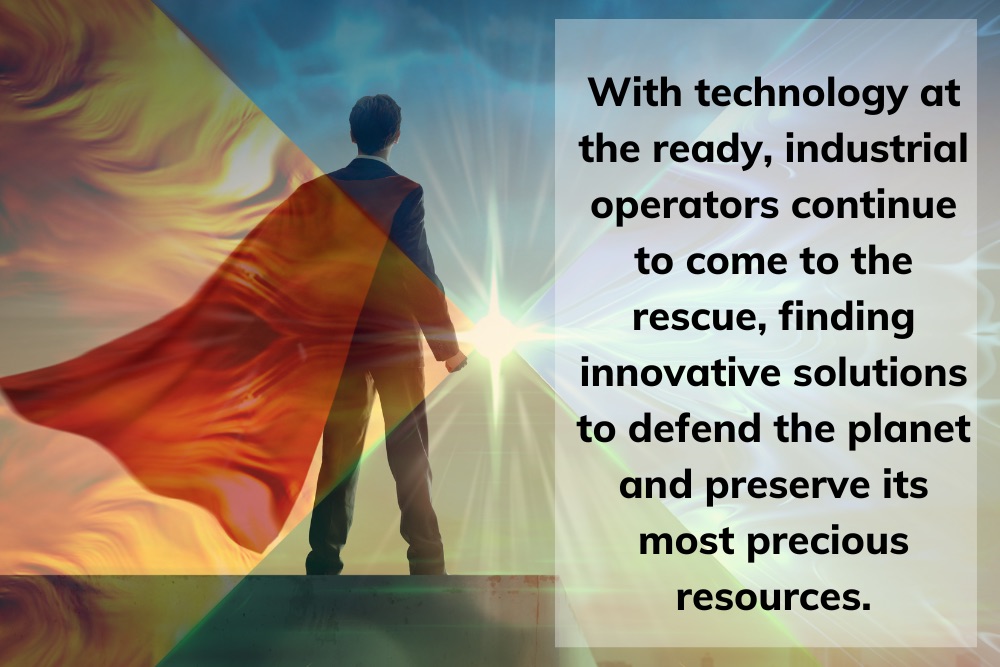
With fresh insight and excitement for the year ahead, the FreeWave leadership team discusses their vision for the future, predictions about the evolution of data, and collective approach to protecting life’s essentials. Though you might not find their names in the next Marvel film or DC comic book, industrial leaders – whether in agriculture, energy, utilities, or another resource industry – are the heroes of the modern world, real-life Guardians of the Galaxy, if you will. These heroes fight today’s challenges every day, while life’s essentials like food, air, energy, and water are threatened daily. With technology at the ready, industrial operators continue to come to the rescue, finding innovative solutions to defend the planet and preserve its most precious resources. At FreeWave, our goal is to continually build upon technology advancements to help you build a better world within your industry. With 2023 right around the corner, we asked four of FreeWave’s senior leaders, including Kirk Byles (CEO), Michael Tate (COO), Parthesh Shastri (CTO), and Jeff Horton (CRO) to share their thoughts on how FreeWave Technologies is helping the heroes of today protect life’s essentials to create a better tomorrow. ___________________________________________________________________ Q: What is one of your favorite FreeWave memories from this past year? Kirk Byles: It’s hard to even remember before this quarter, but the Reinke Dealer Conference was definitely a top highlight for me this year. Not only did it show the work our collective teams have been doing to build relationships and finalize a new product offering, but it was also really cool to see the impact our work is having in real-time, as we partner with Reinke – one of the largest pivot irrigation manufacturers in the world – to help growers and producers save water and raise crops. This was really big. Parthesh Shastri: This year, we really came together across disciplines within FreeWave, too, increasing our focus on target outcomes to deliver products that our customers use and deploy in the field, and we had a lot of fun while doing it! As we look at 2023, we are excited to scale this model and implement it across new industries. Q: How is FreeWave helping industrial operators protect life’s essentials? Jeff Horton: The top thing that comes to my mind is bringing automation to irrigation. We work closely with our partners, like Reinke, to provide real-time analytics, which saves a lot of water and nutrients, and both of these things are invaluable for farmers. Technology also helps to reduce fuel consumption on ranches by eliminating the need to manually check cattle watering tanks. Some producers often spend 12 to 15 hours a week driving around just to look at their water tanks. Think about the wear and tear on those pickup trucks or even the rising cost of fuel. Being able to reduce greenhouse gas and save these guys money while also producing a high return on investment is a really big deal. We can do that easily with the Tank Level Monitor. Mike Tate: And it’s not just the ROI. These producers are suffering. Ranching is not the lucrative business that it once was, and these ranchers are getting beaten at every turn. A lactating cow needs one gallon of water for every hundred pounds, every six hours! Water is a huge concern for both producers and growers, and being able to give them back more time while reducing their expenses is a great value add because every dollar counts for them. Q: Is the word “efficiency” changing for industrial operators? Jeff: When you look at conditions today, both here in the United States and globally, you see so many labor shortages, droughts, inflation, and climate changes, and it’s forcing efficiency, not for efficiency’s sake, but for sustainability and survivability. Businesses have to fundamentally change the way they produce a product, and they have to find the least expensive, most efficient path to go to market. Efficiency isn’t an option anymore; it’s a necessity. Kirk: For years, everybody has wanted to do more with less, and usually, there’s some sort of limitation in the way until someone invents a solution that takes things to the next level. That’s what we’re all about at FreeWave. We’re not doing anything necessarily earth-shattering; but we are innovating. We’re providing a mechanism for our customers to become more and more operationally efficient – to increase their bottom line – and make things better, and not just for their business, but for their employees and life, in general. Case in point: oil and gas companies, considered by some to be big polluters. However, these companies have many sustainability and environmental initiatives and tenants they strive to uphold. They are a critical component of our everyday lives. They’re evolving and innovating, too. FreeWave, helps them get the most out of the equipment they have on-site so that they’re more effectively getting the oil and gas out of the ground with minimal impact. Overall, a more efficient company means less impact on the environment, and these kinds of solutions help create a better planet. Q: In your wildest imagination, where can technology take the industrial leader in the next ten years? Parthesh: There are so many great examples. In China, there’s currently a 12-story tall facility being built to raise hogs in a conditioned environment. It’s like an office space for swine. In this environment, technology is being used in such a way that human intervention is really minimized, and because most things are entirely data-driven, they are able to be a lot more efficient. Now, there are pros and cons to what’s taking place there, and we won’t know the final outcomes for a while, but the march of technology is going to continue to go on, and I believe we will continue to see a lot more practices like this in the future. Jeff: Another example is indoor growing facilities in Saudi Arabia and Qatar. Massive facilities that are purpose-built for farming simply because there is
Ranch Life: Water Visibility is Critical Part 2
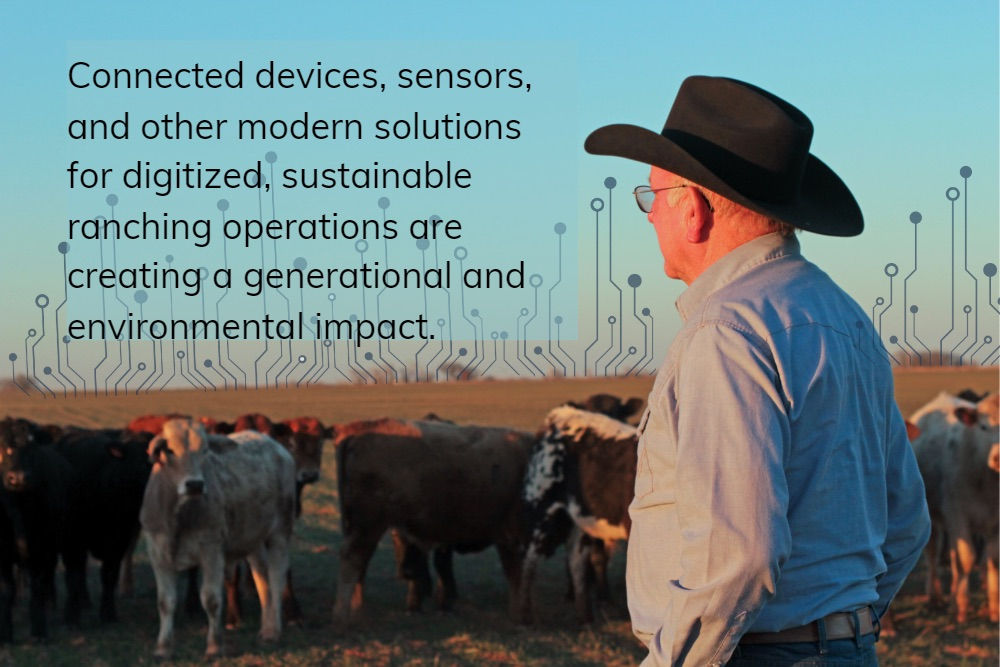
Measurement is part of a farmer’s DNA. It improves plant yields, herd health, resource conservation and impacts the bottom line – from ensuring livestock reach their peak for maximum prices at auction to guarding against overgrazed pastures. Observation and measurement, especially for the stewards of our land, determines performance in many categories of a ranch’s operations. In Part 1 of this series, we explored how the metrics of today and those of the original homesteaders varies in one significant way: technology. A quick recap: The Internet of Things (of the ranch) or IoT is like having an extra set of “eyes and ears” spread across the ranch. In short, connected devices are bringing near real-time visibility into what is happening in disparate parts of the ranch. How do all those devices spread across thousands of acres bring value? Here are five scenarios modern ranchers are using to transform their operations. Scenario One: Instead of rolling out trucks to check water usage in stock tanks, ranchers are saving time using alerts or checking tank levels on their devices Tank level and creek/river monitoring solutions (FreeWave Water Level Monitor) help ranchers manage water usage better. In the past, and to some effect still today, farmers and ranchers don’t know how much water they use. Inexpensive and simple-to-deploy sensors in tanks, aquifers, springs, and pumps allow ranchers to know exactly what is happening with water usage and make intelligent decisions about watering pastureland and hayfields, filling tanks, and moving water. (click here for a special price offer for a limited time) Ranchers are in the “driver’s seat” (without ever leaving their chair) by setting parameters – thresholds like water levels or flow. Technology can seem complicated to many of us sometimes, but the IoT devices we are talking about are not. Drop-in remote sensors simply plug in so ranchers can see what’s happening, in near real-time, rather than driving across thousands of acres in a gator to check hundreds of troughs and water supplies. Ranchers can easily monitor water levels in tanks 24/7 without routine in-person maintenance checks. (Bonus: there are no set-up fees with our solution.) Scenario Two: Paperwork is easier and faster using real data. Less manual inspections mean safer working conditions and less vehicle costs A digital ranch goes beyond automatic water distribution; it also includes insight and access to data metrics to help monitor and stay within local water use regulations. Ranching operations require lots of paperwork, especially those using public lands for grazing. For irrigation systems that take water from a natural resource such as an on-farm stream or river, data helps ranchers measure water availability and flow. By rolling out fewer trucks to check on stock tanks, there’s less wear and tear on trucks and less man-hours dedicated to manual inspections. Scenario Three: Soil moisture level monitoring improves grazing health Not only can digital solutions enhance the quality of water production on a ranch, but they can also play a role in helping to visualize and maintain the quality of the soil for high quality grass for grazing. Sensors determine soil moisture levels and overall health from the air. Better soil means a better ranch, and a better ranch means healthier land, livestock, and profitability. With near real-time data in hand, ranchers can make more informed decisions – just like they always have through observation and measurement – about soil behavior. For example, knowing actual soil moisture levels influence when to rotate cattle on different fields so ranchers can fertilize the land, continually giving fresh grass for the cattle to munch on. Scenario Four: Preparing for adverse weather A string of hot days, the possibility of wildfires, and water scarcity along the Great Plains changes the game for ranchers. No one can control the weather, but technology can help ranchers prepare. Virtual visibility into the surrounding climate of a ranch utilizes timely data to prepare and respond to natural weather updates and climate changes like wildfires, wind erosion, or soil erosion that might threaten ranchland management. Good decision-making and preparedness reduce energy costs and environmental impact. Scenario Five: Carbon dioxide detection is no longer a guessing game Last, but certainly not least, carbon dioxide detection is a game-changing tool for today’s rancher. With the right sensors in place, you can both manage your carbon dioxide emissions and monitor your CO2 levels to ensure better, more drought-resistant soil, which will ultimately aid in the sustainability of water conservation practices. With technology being the “ears and eyes” of the rancher, less money is spent on diesel and, as previously mentioned, wear and tear on trucks rolling out to different sites. The Road to Lean and Mean For those tending vast, open, and oftentimes remote expanses of land, FreeWave’s simple-to-use solutions are turnkey. These modern solutions for digitalized, sustainable ranching operations are creating a generational and environmental impact. They are up and running within 10 minutes or so. Using just about any device – cell phone, tablet, laptop, or desktop computer – ranchers see a dashboard, or what we like to call a single pane of glass. It sounds almost crazy, but FreeWave technology can work in virtually any environment, no matter how remote. Like many customers we serve, we put in our time to hone our craft: we started 30 years ago as a U.S. manufacturer of mission-critical wireless data radios operating in the harshest and most dangerous places for the military. FreeWave has created low-cost ranch coverage solutions to monitor stock tanks, water troughs, rivers, dams and other water supplies in areas with limited or no cell coverage using a variety of solutions, including satellite, cellular, Wi-Fi, Bluetooth, and more. Contact us to learn how you can get valuable time and money back from your ranch operations.
Ranch Life: Water Visibility is Critical Part 1
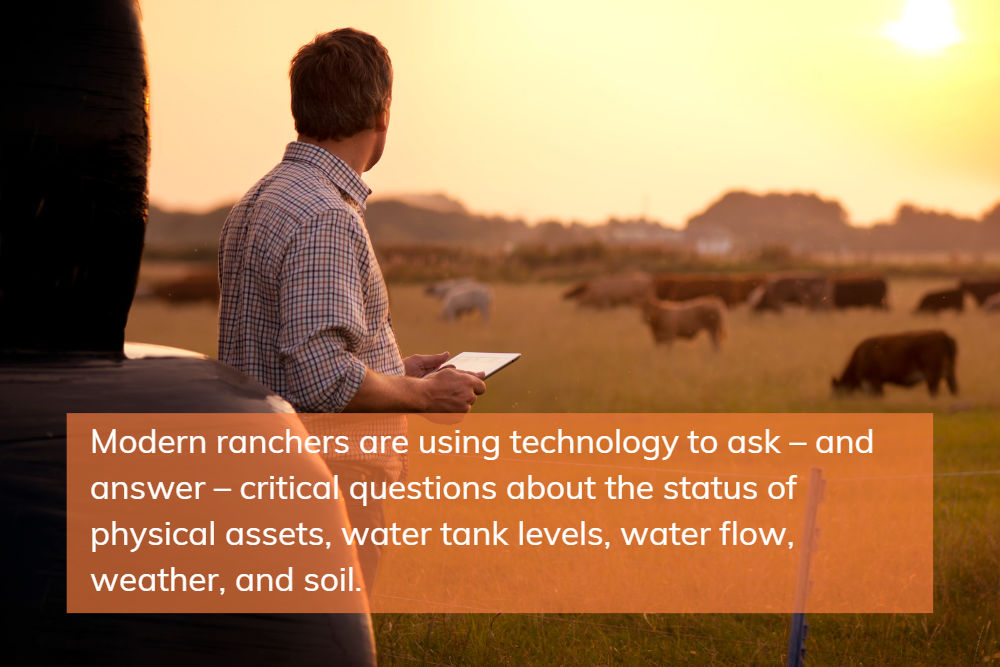
There is no average day in the life of a rancher. Many kickstart their morning at 4 a.m., when most people are still fast asleep. After breakfast, the real work and the long day begins. It might include mending fences, checking grass levels across thousands of acres, rotating cattle or even being called unexpectedly to tend to a neighbor’s sick animal. All this is done by riding the land or rolling out trucks in hard-to-reach places with little or no cell coverage – and so much connects back to water. From land and hay operations to logging and livestock operations, water conservation touches almost every aspect of ranch performance and profitability. Take JJ Goicoechea, for example, who travels at least 40 miles a day (one way) to check on the viability of the water on his land for the surrounding cattle and wildlife. Or Bob Skinner, who used his own funds to purchase an airplane as a means to check on his pipelines every 48 hours. These examples, courtesy of the Public Lands Council, show observation and measurement for better on-ranch performance is nothing new for ranchers. What has evolved is how the modern rancher observes and measures today with near real-time visibility, particularly when it comes to water management. Water Becomes a Commodity It’s no secret that water is a rancher’s most valuable asset. Safe, clean, abundant water sources are necessary for the health of the herd. Water impacts the profitability of ranch operations, many of which were handed down from previous generations. There’s a new challenge, though, that the men and women who homesteaded the land did not have to contend with: extreme weather and unreliability of water sources. Case in point: 2012, when two-thirds of the lower 48 states were in a drought. Or earlier in 2022, when according to the U.S. Drought Monitor, more than 32% of western states, including Texas, Utah, Oregon, and New Mexico, were in a severe drought – the worst megadrought reported in 1,200 years, according to Scientific American. With the unpredictability of nature and the need to conserve reliable, clean sources of water, a better, more efficient way to store and sustainably save water is surely needed. What if You Could See the Entire Ranch on Your Device? Just like their forefathers, a rancher’s keen eye for observation and measurement serves them well. There’s a gut check to making decisions, and experience guides the way. That will never change. The modern cowboy, however, is evolving in one significant way: they can now see their entire ranch operation in real-time on a connected device: cell phone, tablet, laptop or desktop computer. Here is how near real-time visibility – being able to see the different parts of a ranch without physically being there – works. Sensor technology “carries the water” for ranchers and farmers, helping them visualize what’s happening across thousands of acres without having to physically roll out trucks. These devices, or “things,” then relay data back to ranchers so they can make informed decisions based on near real-time visibility. It’s like having extra “eyes and ears” spread across the ranch. In short, these connected devices are the Internet of Things (of the ranch) or IoT, for short. FreeWave provides a drop-in solution – our Tank Level Monitor – that’s easy to install, set-up, and manage. For any of us, you don’t know what you don’t know. For ranchers, this knowledge gap comes with a price as rising fertilizer, equipment, and input costs squeeze margins. Every unexpected cost is closely watched. A dehydrated calf in peril costs more than a thousand dollars to replace. A blown tire on a truck shows up on the P&L. Man-hours spent checking water levels and the status of equipment add up. When it comes to water consumption, IoT is making a difference. According to a research report conducted by Transforma Insights and 6GWorld, by 2030, connected devices and the information they impart will help conserve close to 230 billion cubic meters of water. What does that even look like? Here, we turn to beer to help us out. Considering 40 million cubic meters of water is equal to about 300 billion pints, IoT is predicted to save the same amount of beer consumed at Oktoberfest in Munich for two straight decades. That’s a lot of water saved. While 35% of those savings will come from smart water grid operations, the remaining 65% will be driven by “IoT-enabled agricultural operations like crop management and remote pest control,” according to the report. What Observing and Measuring Means Today Connected devices save valuable time, money, and resources. They give ranchers “eyes and ears” into their entire operation and support what these stewards of our land have always done well: observation and measurement. Modern ranchers are using technology to ask – and answer – critical questions about the status of physical assets, water tank levels, water flow, weather, and soil, like: Do the stock tanks have enough water to keep the livestock healthy? Is there excess water in the soil that will lead to ponding? Are we irrigating the hay fields with too much or too little water? Are equipment like livestock trailers and tractors running smoothly? What’s the condition of remote pumps – are they working, is there a leak, is the herd getting what they need when they need it? A long-held rule for ranchers is that they don’t quit when they’re tired, they quit when they’re done. We aim to support ranchers in getting more of the right things done – with less water, waste, and worry. Talk to FreeWave today and see how our solutions can help you save time, energy, and money with a drop-in solution that just makes sense.
Technology Revealed: Unraveling Data Accessibility for Industrial IoT
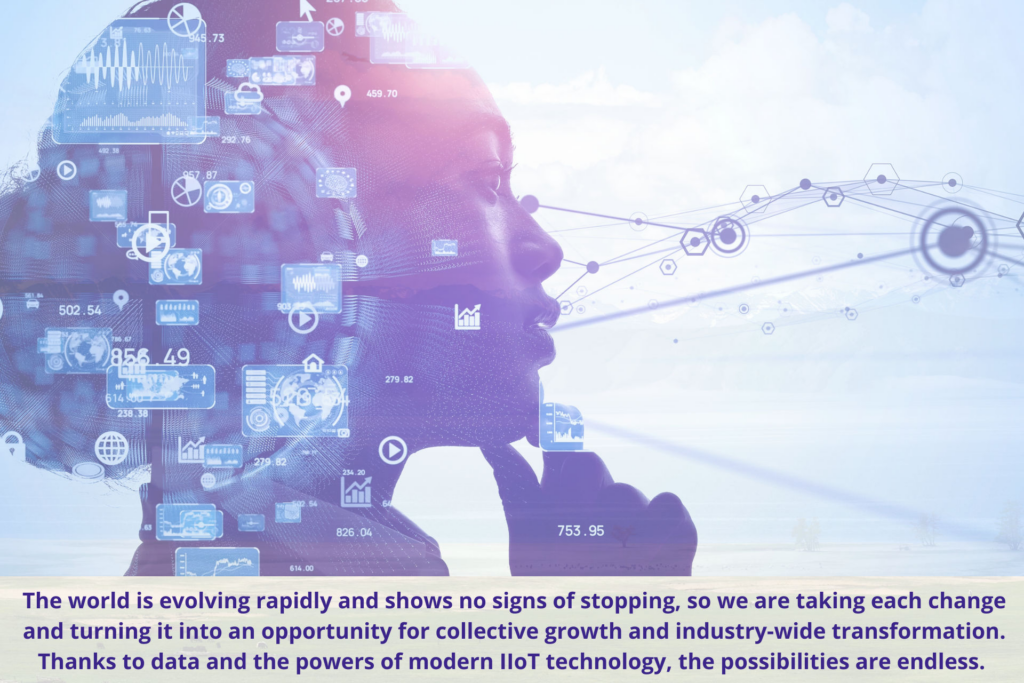
Our world is full of endless possibilities. Thanks to modern technology, we are more digitally connected than ever before. According to Statista, there will be upwards of 30.9 billion connected internet of things (IoT) devices by 2025. From smartwatches and traffic cameras to medical sensors and security systems, the more technology in effect, the more data we are able to collect. If you’ve heard it once, you’ve heard it a hundred times: data is everywhere, and it continues to be an incredible asset for leaders across industrial environments. Today, our widespread access to data allows us to make informed and intelligent decisions based on accurate intel. Something as simple as knowing soil moisture levels or the outside temperatures helps us respond to environmental needs in strategic ways. While data accessibility is undoubtedly a positive thing, it doesn’t mean much if we don’t have the tools needed to act upon those same data insights available to us, and this is where technology makes a tremendous difference, especially for industrial leaders. When we take the revolutionary power of the industrial internet of things (IIoT) and pair it with the wide range of data metrics available, we can intentionally foster better industrial environments across the globe. Our increased access to data, paired with the modern revolution of IIoT technology, allows us to respond to real-world problems with timeliness, precision and contextual intelligence. Together, this dynamic pair fosters safer, faster and more efficient environments for all. The power of time and context When it comes to data accessibility and Industrial IoT, there are many profound revelations of impact, time being just one of them. In industrial environments, timing is everything. It’s the difference between a healthy crop and a wasted harvest for the smart farmer; it’s the difference between an uncontrolled wildfire and a self-contained outbreak for the modern firefighter; it’s even the difference in what could’ve been merely a small oil leak rather than the environmental disaster we now know as the Deepwater Horizon oil spill. Data accessibility provides us with timely information on the surrounding contexts of our environments, and with the right tools, we can respond to this information faster and more efficiently than ever before. Contextual intelligence Next in line to the value of timing, lies the power of contextual data, also known as contextual intelligence. Contextual intelligence is a game-changer for the industrial leader, as it provides a deeper level of understanding and offers an enhanced sense of accuracy for production. Think of any environmental disaster, be it a forest fire, dust storm or even a carbon monoxide leak. While IoT solutions cannot prevent these events from happening, they can provide immediate insight to these occurrences based on contextual analysis. With the right sensors in place, data is retrieved and distributed, making room for timely interception. With the proper insight, operational leaders and manufacturers can observe what’s happening in critical environments and make intelligent decisions based on the contextual data available. Today, IIoT solutions allow us to control external environments virtually anywhere in the world without laborious human intervention. In this modern age, the simple switch of a button or command from a control center can adjust the outputs of remote operations everywhere. We call it a single pane of glass approach. When emergencies arise that need immediate attention, these same IIoT solutions help us respond quickly and efficiently, ultimately maximizing people’s time more effectively. The role of intelligence In addition to time and context, the third component is intelligence. Data takes the guesswork out of problem-solving and invites us to respond with precision-based strategies. Think about smart farmers, for example. With proper insight into the correct data like soil moisture levels, external temperatures, climate measurements and other relevant intel, these farmers can cultivate the most favorable conditions for a quality harvest. Without this information, farming becomes a guessing game that varies from year to year, but when this data is paired with IIoT solutions, agriculture becomes much more about intelligent strategy. Looking ahead, the digitization of farming is quickly becoming a necessary solution. Our world population is rapidly increasing every day, leading us to grow by 2 billion people in the next 30 years alone! A significant increase in people requires a significant need for accelerated food production. In fact, it’s reported that we will need to increase crop yields and harvest more food in the next 30 years than we’ve had to produce for the last 10,000 years combined. Though these statistics are extreme, they don’t have to be alarming because with the right technology in place, society will be up for the task at hand. The interconnected work of data and IIoT takes smart farming to a whole new level, making it less of a gamble and more of a controllable process from seed to harvest. Beyond the world of just smart agriculture, data impacts the role and work of IIoT solutions across every industry, including water and wastewater, electricity, oil and gas, transportation and traffic and many others. Our ability to access data empowers us to leverage IIoT technology most intelligently; it’s the “work smarter, not harder” mindset at its finest. Technological pioneers At FreeWave Technologies, we are passionate about creating real-world solutions for everyday needs across industries. In a world that is changing with rapid succession, connectivity is critically important for industry leaders, remote operations and the basic good of society. We need tools and products that help us act on data quickly and precisely, and our line of products is helping our customers do just that. FreeWave products take the complexity of industrial IoT applications and simplify them for the user, creating a digitization strategy that connects data with life. Our easy-to-use applications allow controllers to respond to their deployed assets from one place with timeliness, intelligence and precision. At FreeWave, we are pioneering a new way forward, promoting connection, safety and innovation along the way. The world is evolving rapidly and shows no signs of stopping, so we are taking each
Technology’s Impact on Air Quality Control Monitoring
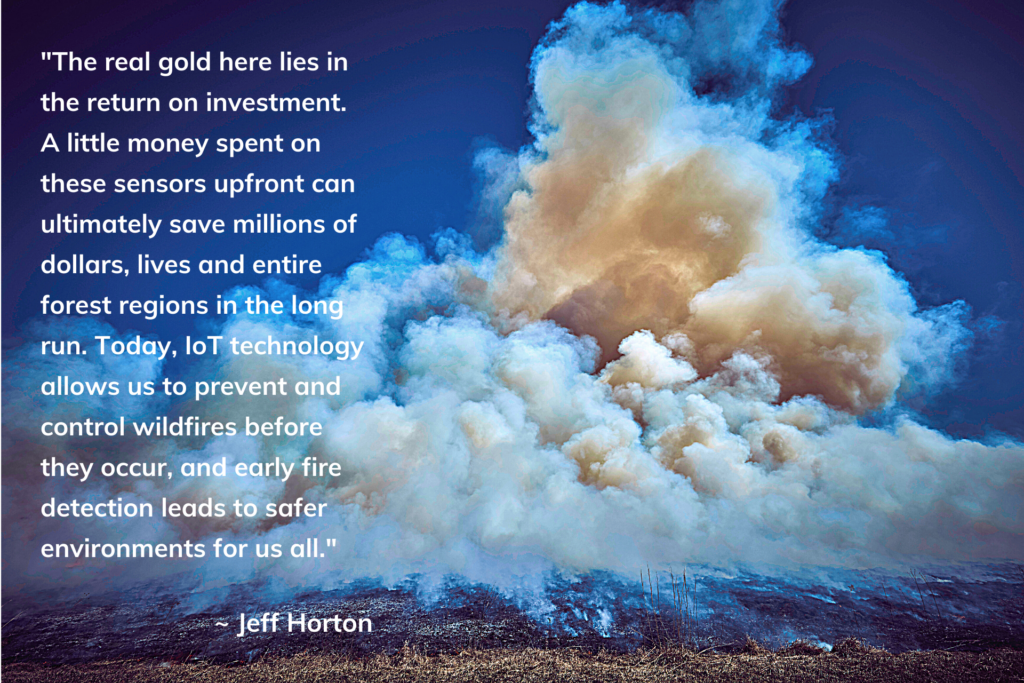
At this very moment, wildfire season is currently underway in North America, and since the start of this year alone, more than 27,000 wildfires have consumed nearly two million acres according to the National Interagency Fire Center (www.nifc.gov). Though many people hear the word “wildfire” and immediately picture a forest in California, the reality is these natural disasters are prevalent across the country. Wildfires are everywhere The Verge, a technology news website, announced recently that roughly 56% of homeowners in the United States face some sort of wildfire risk in the upcoming decades. Bottom line: wildfires are becoming more prevalent and costly every day, and these fires are affecting more than half the population and significantly changing our quality of life. Just a few decades ago, we didn’t have the technology to prevent or predict changes in the surrounding air quality, but now we do, and through it, we can create a better world. Today’s technological advancements allow us to be proactive rather than reactive when it comes to our overall health and safety. By leveraging sensor technology, we have a better chance of predicting and preventing significant changes in the environment, like a drastic shift in air quality before a wildfire begins. This insight allows us to make better decisions based on intentional insights, and our increased access to data provides us with the right information to better control our surrounding environments. Technology is powerful, and this power can and should be used to our advantage. One of my favorite ways to witness the power of technology transforming real-world issues is by exploring the ways sensor technology has a tremendous impact on air quality control monitoring. Today, internet of things (IoT) technology and satellite are the best tools for early detection and prevention of wildfires. Our approach to air quality control Believe it or not, air quality has as much impact on the world as the daily temperature. With climate change causing drastic shifts in the environment, it’s important that we pay close attention to the quality of the air we breathe, as it affects our overall quality of life. As you know, trees play a critical role in our ecosystem, so we must be very intentional and proactive about protecting the forests around us. This is where sensor technology makes a big difference. With a small machine, we can now track and predict changes in the environment and our surrounding air quality, which ultimately helps us control, prevent and predict conditions that lead to wildfires. At FreeWave, we provide autonomous sensors that are strategically placed in remote locations to track and record relevant data metrics such as temperature, humidity, wind, direction and particulate matter. These readings help industry experts know what’s in the air and how the air is changing. Once this data is collected and transmitted to the cloud, we are then able to analyze it and provide alert and proactive responses where needed. We have created a single pane of glass approach, where anyone with access can log into a portal and see in real-time what is happening in the areas surrounding their deployed sensors. The interesting thing about our sensors is that they are fully powered by solar energy, and satellite signals transmit the recorded data. We are basically offering a “buy, install and forget” resource that makes life significantly easier for industry and environmental experts. There is a ton of value here. Not only are we taking an in-depth look at what’s going on in the environment through air quality control monitoring, but we are also taking that information and transforming it into action. The real gold here lies in the return on investment. A little money spent on these sensors upfront can ultimately save millions of dollars, lives and entire forest regions in the long run. Today, IoT technology allows us to prevent and control wildfires before they occur, and early fire detection leads to safer environments for us all. A unique human aid We are making life simpler and safer for all by using technology to do what humans can’t. Back in the day, people had to sit in an operation tower for hours, looking out to catch any major changes in the environment. Today, there is a major shortage of people willing to do this kind of work, and can you blame them? As humans, we can only be in one place at a time doing one thing at a time, but with technology, this is not the case. With simple sensors, we can now monitor and control a lot more environments at a much more affordable rate. All this to say, the goal here is not to replace humans with technology as some might think; what we are really doing is enhancing human ability through the power of technology. I’ve worked in technology for over 30 years, and every day I witness its evolution. I know it’s hard to imagine a world without cell phones, but I can still clearly recall the days when cell phones took up the entire trunk of a car, and now look at the world, most of us carry the same ubiquitous smartphone in our pockets. Technology is amazing, and we have the opportunity to use it to our advantage. At FreeWave, we are taking the capabilities of mobility – LTE, 4G, Satellite, Wi-Fi, Bluetooth, 900 MHz– and marrying them with sensors. The data we gain from these sensors is saving us time, money and resources. At the end of the day, we’re taking away the need to “overthink” industry issues, like how to better prevent forest fires, and instead are replacing our questions with data-informed predictions and timely proactive responses. Every day, we strive to provide industry leaders with the tools and technology needed to spearhead faster and safer environments for us all. This is certainly not a boring business, and I thoroughly enjoy working for a company that is using technology to have an impact on the things that matter most.
Got Data? Now what?
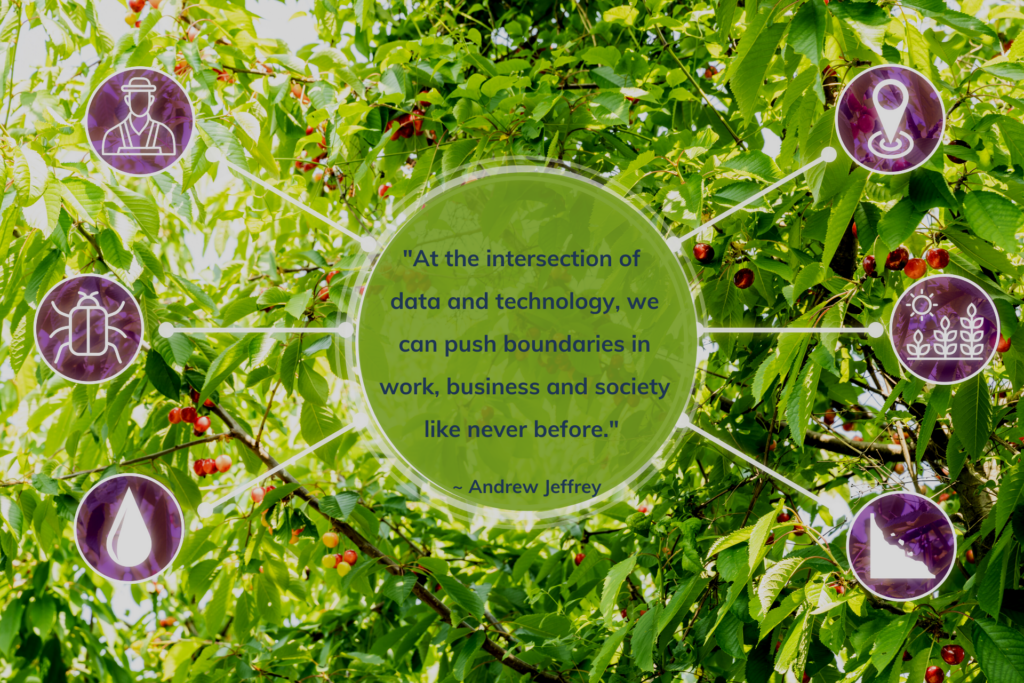
It’s hard to imagine a world without the daily convenience of modern technology. Just yesterday, I joked with my kids about the world before the internet – a time when we actually had to go to the library to look up unknown information. I can still remember the early days of my college career back in the late 90s, the internet had just come out, and we were all getting used to this new phenomenon called a “search engine.” Life has drastically changed over the last 25 years. Now, nearly all the information we want and need is at our fingertips. Today, we have more access to data than most people know how to handle. Data is all around us, collected through the day-to-day actions and reactions of our lives. When we take the time to intentionally analyze, interpret and distribute the data metrics available to us, we can make smarter and more efficient decisions. There is so much to explore, and while our increased access to data is pretty interesting, the reality is that the combination of data and modern technology can change the world. Like many things, though, there are two sides. Sure, industrial companies can capture huge amounts of data, but it also raises the question: now what? How do you put all that data to work? Breaking barriers and pushing boundaries At the intersection of data and technology, we can push boundaries in work, business and society like never before. Data insights allow us to be more precise and accurate in our day-to-day work, which allows us to be more effective and efficient. The operational benefits here are endless, including improved quality control, reduced energy consumption, enhanced safety and increased operational consistency. Just take a look at the food industry, for example. Many field workers in smart agriculture rely heavily on data insights to control, predict and create the best environments for quality crops and harvest. The more accurate their predictions, the better their harvest, and the better their harvest, the faster we receive our food through the supply chain. Today, internet of things (IoT) technology can connect remote and mobile assets, like a tractor, for instant data access, making it easier for farmers to be more efficient and effective in their work. It’s really amazing when you think about it. Data is transforming how we operate in this world, creating better environments for us all. The FreeWave impact At FreeWave, we are constantly pushing the boundaries of technology to create faster, smarter and more efficient work environments. I’ve been a part of the FreeWave team since 2019, and I am constantly amazed at the ways our technology provides innovative solutions for real-world issues. Our products enable our customers to improve their work processes, and through our single pane of glass approach, we offer a simplified experience for businesses and industry leaders to receive automated technology that transforms data metrics into real-time execution. One of my favorite use cases to discuss is FreeWave customer that uses drone technology to deliver food and other valuable resources to far-reaching areas across the globe. With FreeWave products, they can run a smarter and more efficient operation. Their robotics delivery system is combating many of the complex access challenges the world faces on a daily basis. Our IoT technology is helping them solve complex issues with simplified tech solutions, and simple solutions create more time, energy and space to focus on what matters most: people. If you need a product to help you bridge the gap between technology and data, FreeWave is your solution. We are enablement partners, helping every one of our customers accomplish their complex goals. It’s inspiring to work with brands and businesses striving to create a difference in real-world issues. Our technology plays an intricate role in sustaining work environments and supporting entire industries around the globe. Data makes the difference At the end of the day, data is more than mere statistics; data is the key to our efficiency, productivity and safety. Data makes the difference in energy consumption reduction. Data makes the difference in the overall quality and safety of our daily environments. Data makes the difference in everything. Every day we have the opportunity to use data to our advantage, and at FreeWave, we are helping industrial innovators do just that. As technology continues to evolve, we will continue to provide top of the line IoT solutions that transform data into actionable insights and execution so you can not only access a treasure trove of data, but also know exactly how to answer the age-old question: now what?



